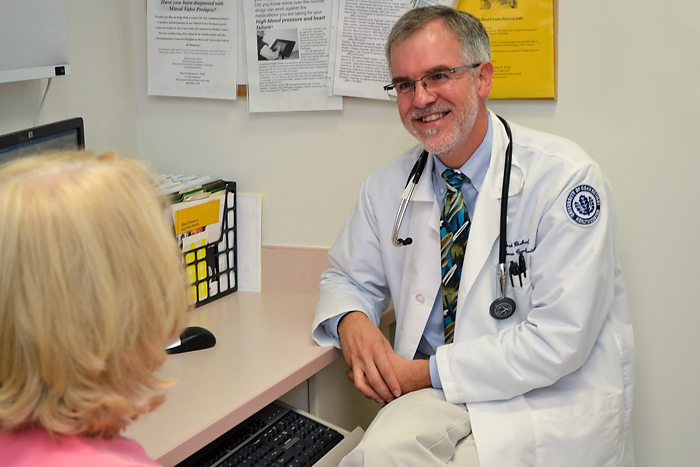Exercise as Medicine
Did you know that there’s a prescription that can help prevent and treat many health problems? Exercise is crucial to the prevention, management, and treatment of numerous chronic conditions. Learn how to boost your energy, reduce or eliminate the need for medication, and control:
- Cholesterol levels
- Diabetes
- Hypertension
- Stress
- Weight
- Depression/anxiety
Date: Tuesday, September 25
Time: 7 to 8 p.m.
Location: ARB Building, Large Conference Room, Ground floor (EG013)
Speaker: Bradley Biskup, P.A.-C., Lifestyle Modification Program, Pat and Jim Calhoun Cardiology Center
The Lifestyle Modification Clinic at the University of Connecticut Health Center offers patients an alternative to the typical weight loss programs or fad diets.
Marlene Francis said she was considering doing Weight Watchers for the second time when a co-worker told her about the clinic.
“I decided no, I don’t want to do this anymore. I’m tired of doing the yoyo,” says Francis. “I gained more weight when I went off Weight Watchers. To me, the Lifestyle Modification Clinic is not a fad diet; this is a lifestyle change. It makes you more aware of how your body works and focuses on how you live every day.”
The Lifestyle Modification Clinic was started in the spring of 2010 with support from the Pat and Jim Calhoun Cardiology Center. The staff consists of cardiologists Joyce Meng, Anjanette Ferris, Peter Schulman, physician assistant Brad Biskup, registered nurse Dawn Smith, and exercise physiologist Gina Correa.
“It focuses on a niche that doesn’t get covered,” says Biskup. “It’s about giving patients a place to go where they can take control and it empowers them to find out what their other options are beyond medication.”
Patients who are eligible for the Lifestyle Modification Clinic are those with coronary artery disease, peripheral artery disease or carotid artery stenosis, history of a stroke, diabetes, hyperlipidemia and hypertension, or who has been a patient at the Cardiology Clinic or Hypertension Clinic within the last three years.
The care at the clinic is very individualized. It is about looking at a patient’s lifestyle, their behaviors and their limitations, and then modifying them.
The initial visit includes reviewing previous lab work and doing a cardiovascular risk assessment. After this, an analysis of the patient’s current diet, as well as exercise routine and history are obtained. This helps to develop the goals and the plan to obtain them.
“We do a lot of education,” says Biskup. “The more education they get – the better.”
Francis says the small, achievable goals and the explanations are a big part of what has helped her stay motivated. Since she started going to the clinic in November 2011, she has lost 50 pounds and her cholesterol levels are less than half of what they had been.
“Brad gives you homework assignments and things to look for. He gives you a lot of samples and tools to guide you and help you to succeed. I think that’s what has helped me make a difference in my life,” she says.
The difference between the clinic and fad diets or other programs is the focus on what is important. “It’s not just about weight. It’s about your cholesterol, blood work, and how your body works. For the first time in a long time my blood work has been normal,” she says. “Seeing the scale is only one difference.”
Biskup says the clinic works with patients to find activities that they enjoy doing, as well as finding healthy foods that they already like to eat and incorporating them into daily life. He says they consider a patient’s work schedule, family life, living environment, financial restrictions, pain restrictions, and stress. He adds “to successfully modify behavior, you must first understand the behavior.”
He looks at both exercise and activity as ways to being healthy. If you are unable to exercise on a regular basis, the alternative is using a pedometer to obtain a certain number of steps per day. The opportunity to increase activity such as taking the stairs or parking at the far end of the parking lot is also encouraged.
“The stigma of exercise is that if you are not sweating and short of breath, you’re not getting any benefit. This couldn’t be further from the truth. The “talk test” is one of the most reliable markers for appropriate intensity of exercise. If you are short of breath while exercising and can’t say a complete sentence, you are exercising too hard and are increasing your risk of injury, as well as the likelihood that you won’t continue exercising,” says Biskup.
Francis walks three miles every morning before work and challenges her husband and 19- and 16-year-old children to Wii Fit challenges. The family now replaces store-bought salad dressing with homemade salsa and olive oil and uses turkey and chicken in salads instead of lunch meat.
“Seeing how well patients have done is the most rewarding thing for me. Yes, weight loss is great, but seeing them stop medications and still improve their risk factors is testament to their hard work,” says Biskup. “It’s amazing to see the empowerment with a little guidance.”
Follow the UConn Health Center on Facebook, Twitter and YouTube.



